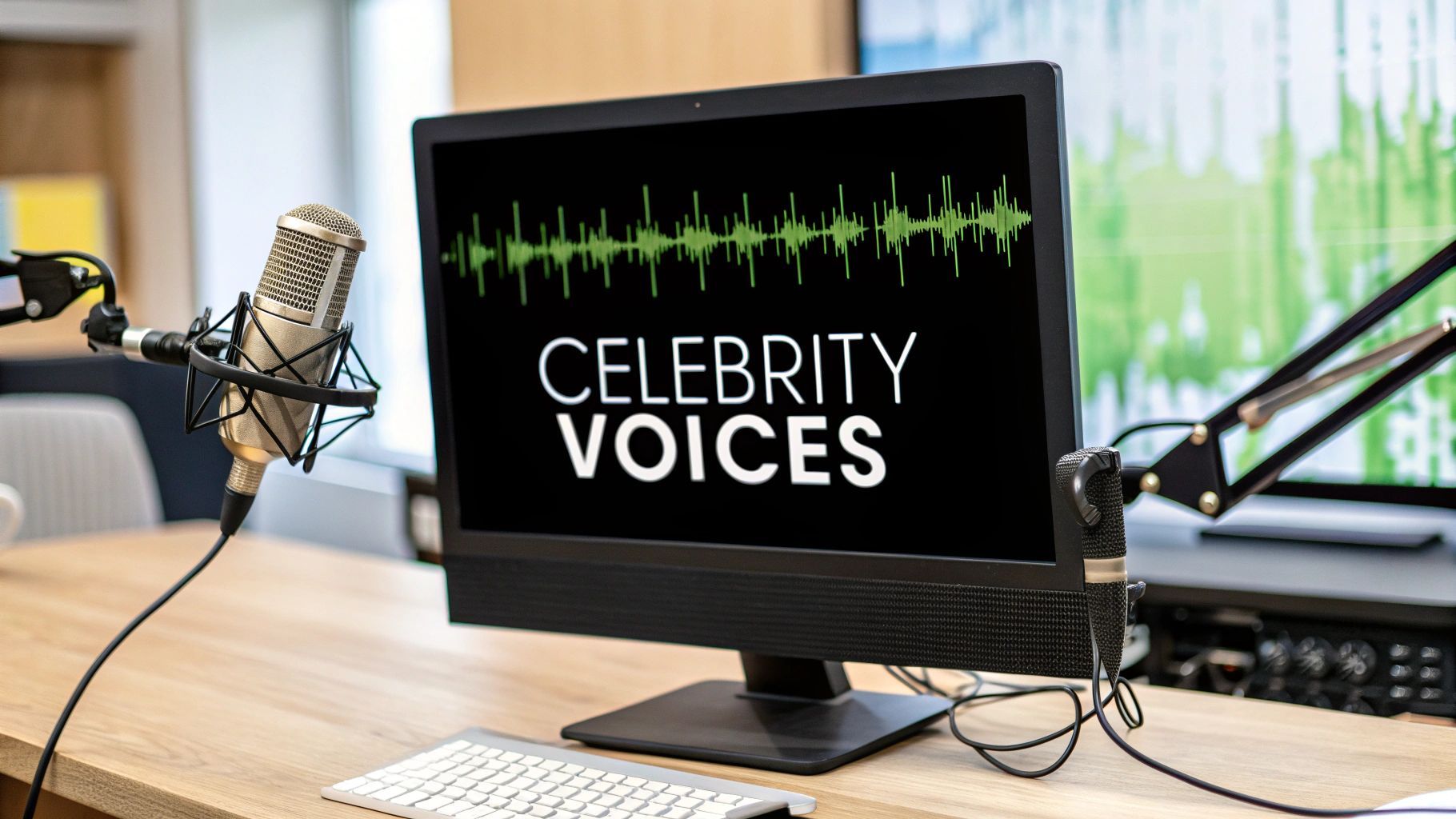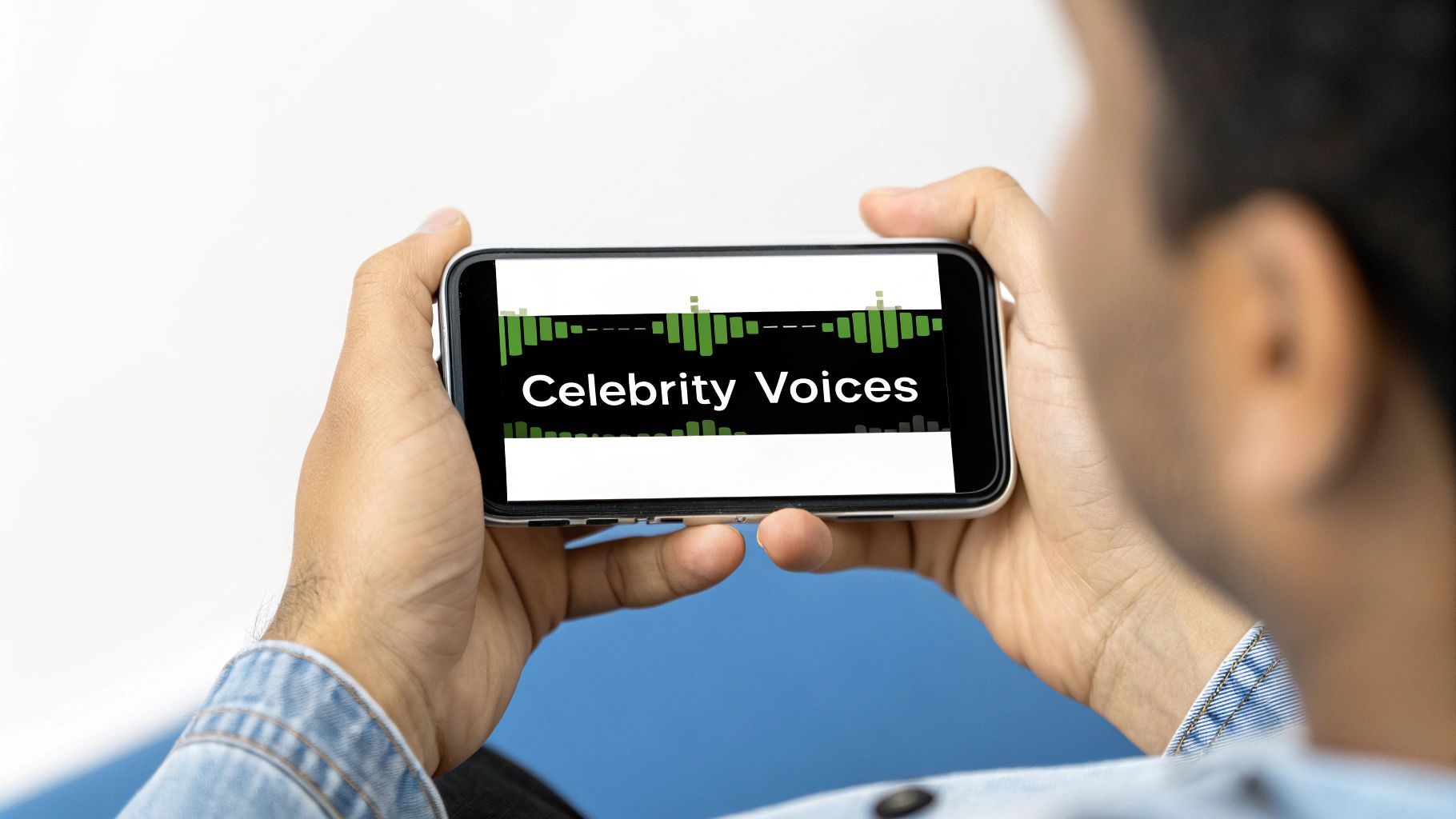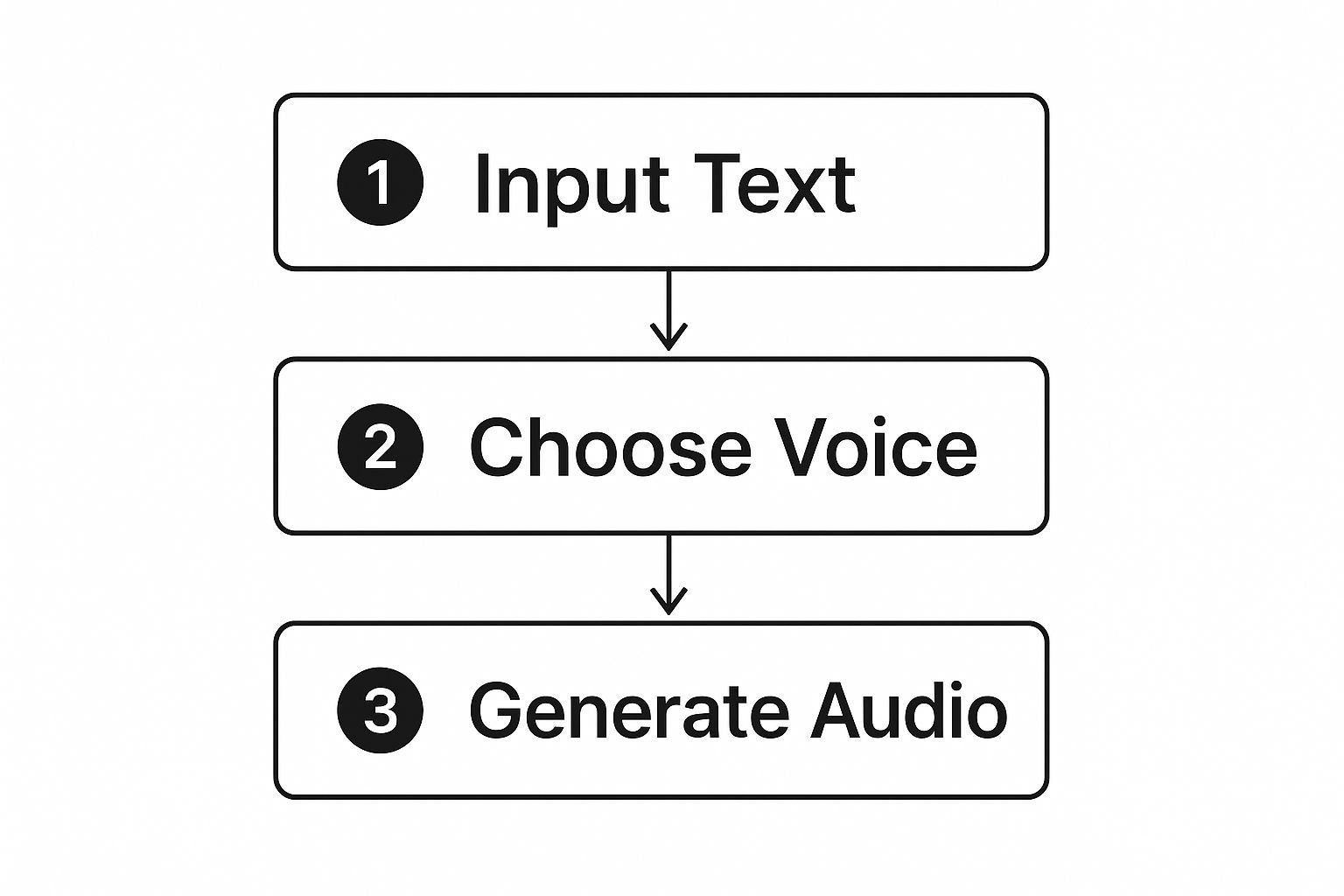Top 7 Unique Personalized Gifts for Friends in 2025




Discover how to use text to speech celebrity voices to create professional audio for any project. This guide shows you how to get started.
Ever fantasized about having a blockbuster movie star narrate your next project? Well, welcome to the wild world of text to speech celebrity voices, a seriously cool piece of tech that’s completely changing the game for audio creation. Think of this guide as your all-access pass. I'm going to show you exactly how platforms like SendFame can take a simple script and transform it into a captivating performance from a voice everyone recognizes.
Forget the dense, boring technical jargon. We're jumping straight into the practical magic: how you can whip up high-quality audio for anything from a goofy social media clip to a slick podcast intro or even a personalized message. We'll look at how this technology went from being a niche tool to a creative powerhouse, putting professional-grade voiceovers right at your fingertips—no recording studio required. Get ready to have some fun and make your content impossible to ignore.

The image above gives you a peek at the SendFame dashboard. As you can see, it's all about browsing the library of voices and getting from an idea to a finished audio file in just a few clicks. It's built to be intuitive.
This tech has an incredible backstory. Text-to-speech (TTS) first appeared way back in 1968 as an accessibility tool, most famously giving a voice to brilliant minds like physicist Stephen Hawking. Fast forward to today, and AI has supercharged its potential, cloning celebrity voices with startling realism for entertainment, marketing, and everything in between.
This evolution has blown the doors wide open for creators like us. No longer just a functional tool, AI celebrity voices are now at the heart of a massive creative wave.
The concept is beautifully simple: use the instant connection and appeal of a famous voice to make your own content more engaging, fun, and memorable.
The uses are surprisingly vast and can give you a serious edge in a sea of look-alike content. When you drop a familiar voice into your project, you instantly boost its "wow" factor and create an emotional shortcut with your audience. For a bigger picture on how AI is shaking things up, check out some great resources on AI for content creation.
AI voices aren't just a novelty; they have the power to genuinely elevate your work. The table below breaks down how they can inject some serious star power into different projects.
| Project Type | Impact of Using AI Voices |
|---|---|
| Social Media Clips | Grabs attention instantly, boosting the potential for going viral. |
| Podcast Intros | Gives your show a polished, high-production feel from the first second. |
| Personalized Greetings | Creates unforgettable, fun moments for birthdays or special announcements. |
| Explainer Videos | Lends authority, humor, or charm to otherwise dry instructional content. |
The best part? No need to have a Hollywood agent on speed dial. Here are just a few real-world scenarios where these voices are absolute gold:
Social Media Content: Imagine a TikTok trend or Instagram Reel "narrated" by a famous action hero or comedian. Instant gold. Podcast Intros and Outros: Hook your listeners immediately with a professional, attention-grabbing opening from a well-known voice. Personalized Messages: How cool would it be to send a birthday shout-out or a graduation congrats "from" a celebrity? Video Narration: Add a dose of authority or a splash of humor to your YouTube explainers, tutorials, or product demos.
And you don't need a massive budget to play in this sandbox. With our SendFame text-to-speech generator, you can tap into these voices whenever inspiration strikes. In the rest of this guide, I'll walk you through the entire process, step-by-step, to make sure your final audio sounds absolutely amazing.
Alright, let's get you behind the velvet rope. Before you can have a virtual A-lister voice your next brilliant idea, you've got to get into the club. This is your no-fuss guide to setting up a SendFame account and getting you ready to create your first clip in just a few minutes.
Think of this less like filling out tedious paperwork and more like grabbing your all-access backstage pass. The whole process is designed to be ridiculously fast so you can jump straight into the fun stuff.
First things first, you need an account. Head over to the SendFame homepage, find that sign-up button, and pop in your details. They've thankfully skipped the long, soul-crushing registration form because they know you're here to make awesome text to speech celebrity voices, not to practice your data entry skills.
Once you're in, you’ll see a few different plans. Here's the inside scoop on which one to pick:
Free Tier: This is your playground. You get a handful of credits to mess around with different voices and just see what's possible. It’s perfect for dipping a toe in the water without any commitment. Creator Plan: Got a specific project in mind? Maybe a few social media clips or a slick podcast intro? This is probably your sweet spot. It gives you more credits and unlocks the really good premium voices. Pro Plan: For the serious players—the marketers, podcasters, and content creators with big plans. This tier hooks you up with a massive pile of credits, more flexibility, and first dibs on new features and voices as they drop.
My two cents: Don't stress too much about this choice right now. You can always upgrade later. I usually tell people to start with the free or creator plan to get a feel for the workflow before going all in.
Now for the main event. Using SendFame really boils down to three simple actions: you write, you pick a voice, and you hit 'generate.' That's it. No complicated hoops to jump through.
This image lays out the basic flow perfectly.

See what I mean? They've stripped out all the boring, unnecessary steps. The whole point is to get you from a script to a finished sound file with as little friction as possible. This lets you focus on what really matters: crafting a killer script and finding that perfect voice to bring it to life. The real fun begins when you start experimenting.
Alright, now for the really fun part. With your account set up, it’s time to play casting director in SendFame’s massive library of text to speech celebrity voices. This is where you get to find the perfect star to bring your script to life.
But hold on a second. This isn't just about picking your favorite actor from a blockbuster. It’s a strategic choice. The right voice can grab your audience by the collar and make them listen, turning a simple script into something they’ll actually remember.

Before you get star-struck and start clicking away, pause and think about the feeling you want to evoke. What’s the goal of your project?
Making a YouTube documentary? You'll probably want a deep, authoritative voice to lend your story some serious weight and keep viewers hooked. Creating a social media ad? A witty, upbeat, or even a charmingly sarcastic voice can slice through the endless scroll and make your product feel instantly cooler. Sending a personalized birthday greeting? A warm, iconic, and friendly voice transforms a simple message into a genuinely special moment.
Think of it this way: your voice choice is a massive part of your brand's personality, much like the tactics used in these inspiring brand positioning examples. It’s not just about the sound; it’s about aligning a whole persona with your message.
Pro Tip: It’s tempting to just pick your personal hero, but resist the urge! Instead, ask yourself, "Whose voice would my target audience find most entertaining or convincing for this specific topic?" The answer might be totally different than you expect.
Getting this right is more important than ever. The AI voice cloning market is absolutely exploding—it's projected to rocket from $1.2 billion in 2023 to a staggering $3.8 billion by 2028. This boom means these voices are popping up everywhere, so choosing a truly fitting one is your secret weapon to stand out.
SendFame has a killer feature that lets you "audition" voices without burning through your credits. Trust me, the preview tool is your best friend here. Don't just guess how a voice will sound—hear it for yourself.
Grab a short, punchy sentence from your script, ideally one with a bit of personality. Paste it into the text box and listen to how a few different voices tackle it. This is where you’ll spot the magic (or the mismatch).
Does one voice just get the comedic timing you were aiming for? Does another deliver a line with more power and gravitas than you imagined? Does a particular voice trip over a technical term or your brand name?
This little bit of testing is what separates a decent voiceover from a truly great one. It’s how your project’s personality snaps into focus.
Once you find that one voice that makes your script pop, you’re all set. It's time to create your first full text-to-speech audio clip and finally hear your idea come roaring to life.
Alright, you’ve found the perfect voice for your project. Now for the fun part: making it talk. This is where you, the writer, become a director. The script is everything.
I’ve seen it a thousand times—someone generates audio that sounds stiff and robotic, and they blame the AI. But nine times out of ten, the problem isn't the tech; it's the text. You can’t just feed it a block of formal prose and expect magic. To get amazingly realistic text to speech celebrity voices, you have to get your hands dirty and learn to "speak AI."
Think of punctuation, creative spelling, and sentence rhythm as your director's toolkit. You're about to coach a stellar performance out of your digital talent.
Here’s a secret that will change the game for you: people don't speak in perfectly polished sentences. We take breaths. We emphasize words. We ramble a bit. To get that human touch, you have to write for the ear, not just the eye.
That means chopping up those long, winding sentences. A sentence that looks elegant on the page can make an AI sound like it’s struggling to catch its breath. Go for shorter, punchier sentences. They create a natural, conversational feel that's far more believable.
My Golden Rule: Read your script out loud. Seriously. If you feel like a robot saying it, the AI will sound like one, too. If it feels natural rolling off your tongue, you’re on the right track.
Your new best friends are commas and periods. Use commas to signal a slight pause, like someone taking a quick breath. Use periods to create a full stop, giving an idea space to land before the next one begins. You're not just following grammar rules; you're conducting an orchestra of words.
Once you've got the rhythm down, it's time to start playing with the finer details. While SendFame has sliders for speed and pitch, you can bake a surprising amount of nuance directly into your script.
Ever had an AI butcher a brand name or a bit of jargon? Don't worry, it happens. The fix is often surprisingly simple: spell it out phonetically. If the AI keeps saying "Chipotle" wrong, try feeding it "chi-poat-lay." It might look bizarre in the script box, but the result in the final audio is what counts.
Let’s see this in action.
Clunky Script (Before): "Our new product, which has been in development for three years and incorporates numerous groundbreaking features, is finally available for purchase today."
Yawn. Sounds like a corporate memo.
Dynamic Script (After): "It's finally here. After three years of hard work... our new product is ready. And it is packed with incredible features. You can get yours... today."
See the difference? The short sentences and ellipses (...) create anticipation and drama. It feels like a real person talking.
Some projects call for a warm, relatable delivery. For that, I often recommend a voice that’s built for it. You can learn more about scripting for a friendly, next-door vibe by checking out the Karen Bradey AI voice, which nails that conversational tone.
Here are a few more tricks I've picked up over the years:
Parenthetical Asides: Want to create a "by the way" or "just between us" moment? Try putting a phrase in (parentheses). It can subtly shift the AI's delivery to sound like a quick, whispered comment. Emphatic Repetition: Need to drive a point home? Repeat a word. "This is good. No, this is really, really good." It’s a classic human speech pattern that adds instant emotion. The Power of a Question: Break up a monologue by tossing in a question, even if it's just for effect. "What does that mean for you? Well, let me tell you." It immediately changes the inflection and re-engages the listener.
Master these simple scripting techniques, and you’ll go from generating text to directing captivating, human-like performances.
Alright, you've got your audio clip. The AI did its thing, and it sounds pretty darn good. But hold up—don't slam that download button just yet. This is the moment where we separate the good from the great. A little post-production finesse is what takes a neat AI trick and turns it into something that sounds genuinely professional.
Think of it as the final buff and shine. It's what makes the audio sound crisp, clean, and ready to impress whoever's listening.

This screenshot gives you a peek behind the curtain at the kind of controls you have right inside SendFame. Before you even think about exporting, you can get in there and tweak the performance. This is your first and best chance to get things just right.
Seriously, play around with it! If a sentence sounds a bit flat, try rephrasing it or throwing in an exclamation point. I've found that even tiny tweaks to punctuation can completely change the delivery of your chosen text to speech celebrity voices.
Put on your director's hat. The best performance isn't always from a single take; it's often a Frankenstein's monster of the best parts of several takes. Don't be shy about generating the same line a few times to get it perfect. You can even generate a single, tricky word on its own.
Here's a technique I use all the time for longer scripts: generate the audio in smaller pieces. I'm talking paragraph by paragraph, or sometimes even sentence by sentence. This gives you way more control. Afterward, you can stitch these clips together in a free audio editor like Audacity or a more visual one like Descript to create a seamless, dynamic narration.
My Two Cents: When you're splicing clips, pay close attention to the breathing. It's the secret sauce. A slightly longer pause between sentences can add a ton of dramatic flair, while jumping from one line to the next can build energy. It's all about matching the pacing to the vibe of your content.
Getting these details right is more important than ever. The global AI voice generator market hit around $1.3 billion in 2024 and is projected to skyrocket to $5.68 billion by 2033. That growth is being driven by people just like us in media and entertainment who need high-quality audio. If you're curious, you can read more about this explosive growth and what it means for creators.
Once your voiceover is flawless, it's time for the final, magic touch: building a sonic environment around it. This is what transforms a simple voice clip into something your audience can really get lost in.
Adding background layers is way easier than it sounds and makes a massive difference. Here are a couple of ideas to get you started:
Music is Mood: A subtle, royalty-free music track is the fastest way to set the tone. Go for something upbeat for an ad, or maybe a slow, thoughtful melody for a dramatic story. Sound Effects Add Life: Sprinkle in some sound effects (SFX) to emphasize key moments. A little "whoosh" for a transition, a "ding" when you introduce a new idea, or even the faint murmur of a crowd can make your audio feel alive and real.
When you layer these elements under your celebrity voiceover, you create something rich and textured. It's a simple move that makes your content sound like it came straight out of a professional studio.
Stepping into the world of text-to-speech celebrity voices feels a bit like unlocking a creative cheat code, doesn't it? But with great power comes a few questions. Let's dig into the common queries that pop up when creators first start playing around with tools like SendFame.
Ah, the million-dollar question. The short version is: it's a bit of a legal maze, but good platforms give you a map and a clear path. The core of the issue revolves around something called the "right of publicity," which prevents people from using someone's voice or likeness for commercial gain without their okay.
So, how does this work in practice?
Ethical Sourcing is Key: Reputable services like SendFame handle the messy part for you. They either use ethically sourced, fully licensed voice models or secure the proper rights. This means you get to create without constantly looking over your shoulder. Making Money? Get a License: If you're using a voice for anything that puts money in your pocket—like an advertisement or a product video—you absolutely need a commercial license. Always, always read the fine print in the platform's terms of service. Just for Fun: Creating a hilarious birthday shout-out for your buddy or a meme for your personal TikTok? The rules are usually way more chill. But the second your project becomes commercial, the rules change entirely.
This is where you get to be the director! The AI is your star talent, but it can't read your mind. Getting a truly natural performance all comes down to how you write the script.
People don't speak in formal, clunky paragraphs, so your script shouldn't either. Write in short, punchy sentences. Let your ideas breathe. Punctuation is your secret weapon—use commas for a slight pause and periods for a full stop. If the AI keeps tripping over a specific word, don't be afraid to spell it out phonetically. For instance, if it can't say "GIF" right, try typing "jif" instead.
Here's a pro-tip from my own experience: Don't generate your entire script in one go. Create audio in smaller, sentence-by-sentence chunks. Then, you can easily piece them together in any audio editor. This gives you total control over the rhythm and pacing, avoiding that flat, monotonous drone.
Honestly, your imagination is the only limit here. But these voices really hit different when you perfectly match the celebrity's vibe with your project's goal. It’s all about creating an instant connection.
Here are a few areas where AI voices are absolutely killing it:
YouTube Narration: Instantly add a dose of authority or a splash of humor to your explainers and mini-documentaries. Podcast Intros: Want your show to sound like a million bucks from the first second? This is how you do it. Social Media Ads: Stop the scroll and make your marketing genuinely memorable. Video Game Characters: Give your indie game's characters unique, compelling personalities without breaking the bank on a huge voice cast.
The trick is to think outside the box. If you're curious about how AI is shaking up the industry, check out our piece on the future of the AI voice actor.
Ready to step into the director's chair? With SendFame, you've got a whole roster of A-list talent waiting for your script. From writing the lines to generating pitch-perfect audio, it’s all right there. Start creating with SendFame today!
Create Epic
SendFame